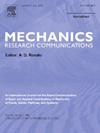Energy absorption and deformation of cellular structures with dovetail joints
IF 1.9
4区 工程技术
Q3 MECHANICS
引用次数: 0
Abstract
In this paper, the dovetail joint is creatively applied to cellular structural plates. Based on the concave cellular structural dovetail joint plates, several new cellular structural dovetail joints with stable quality are designed by chamfering the joints and bending the rods. Tensile experiments of several dovetail jointed cellular structure plates are carried out to investigate the effects of the connection methods on energy absorption and deformation behavior. Finite element models are established and the finite element simulation results are compared with the experimental results for verification. By comparing the different dovetail connection methods, the results show that under axial tensile conditions, the dovetail-jointed cellular structures generally fail at the rod connections. The chamfering of the rod connection and the bending of the rod at the connection can significantly improve the model load-carrying capacity, and when the chamfering or the degree of rod bending is large, the energy-absorbing characteristics of the model can be significantly improved due to the increased stress and deformation of the model's horizontal rods.
求助全文
约1分钟内获得全文
求助全文
来源期刊
CiteScore
4.10
自引率
4.20%
发文量
114
审稿时长
9 months
期刊介绍:
Mechanics Research Communications publishes, as rapidly as possible, peer-reviewed manuscripts of high standards but restricted length. It aims to provide:
• a fast means of communication
• an exchange of ideas among workers in mechanics
• an effective method of bringing new results quickly to the public
• an informal vehicle for the discussion
• of ideas that may still be in the formative stages
The field of Mechanics will be understood to encompass the behavior of continua, fluids, solids, particles and their mixtures. Submissions must contain a strong, novel contribution to the field of mechanics, and ideally should be focused on current issues in the field involving theoretical, experimental and/or applied research, preferably within the broad expertise encompassed by the Board of Associate Editors. Deviations from these areas should be discussed in advance with the Editor-in-Chief.

 求助内容:
求助内容: 应助结果提醒方式:
应助结果提醒方式:


